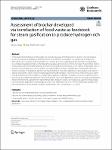Thông tin tài liệu
Thông tin siêu dữ liệu biểu ghi
| Trường DC | Giá trị | Ngôn ngữ |
|---|---|---|
| dc.contributor.author | Yadav, Sanjeev | - |
| dc.contributor.author | Singh, Dharminder | - |
| dc.date.accessioned | 2023-10-03T08:20:25Z | - |
| dc.date.available | 2023-10-03T08:20:25Z | - |
| dc.date.issued | 2023 | - |
| dc.identifier.uri | https://link.springer.com/article/10.1007/s44246-023-00065-1 | - |
| dc.identifier.uri | https://dlib.phenikaa-uni.edu.vn/handle/PNK/9433 | - |
| dc.description | CC-BY | vi |
| dc.description.abstract | In this study, the torrefaction of food waste was carried out using a thermogravimetric analyzer (TGA) to produce biochar and assess its suitability as feedstock for steam gasification. Torrefaction was conducted at temperature from 230 to 290 °C and the heating rate from 10 °C/min to 30 °C/min. Subsequently, the detailed characterization was conducted using proximate, elemental, lignocellulosic, nutrient analysis, and TGA analysis. The proximate and elemental analysis showed that biochar had the highest fixed and elemental carbon at the highest temperature (290 °C) and lowest heating rate (10 °C/min). Similarly, TGA indicated that increase in temperature increased the mass loss, however, increase in heating rate did not yield much change in mass loss. Additionally, lignocellulosic and nutrient analysis showed that lignin fraction increased (up to 80%) with increases in severity of the torrefaction due to significant decomposition of hemicellulose, cellulose, starch, proteins, and lipids. | vi |
| dc.language.iso | en | vi |
| dc.publisher | Springer | vi |
| dc.subject | TGA | vi |
| dc.subject | torrefaction of food waste | vi |
| dc.title | Assessment of biochar developed via torrefaction of food waste as feedstock for steam gasification to produce hydrogen rich gas | vi |
| dc.type | Book | vi |
| Bộ sưu tập | ||
| OER - Khoa học môi trường | ||
Danh sách tệp tin đính kèm:

